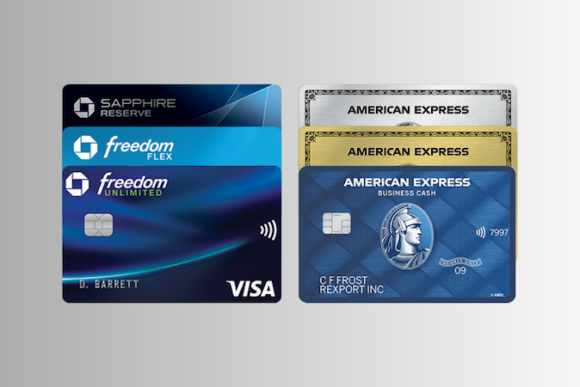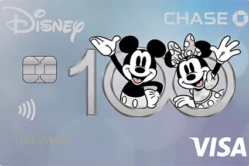If you have the means and want to enjoy the most rewards possible when using credit cards, have you heard of creating a “trifecta”?
Simply put, a trifecta means securing three credit cards that, when used correctly, will give you maximum rewards based on how each card in the trifecta is structured and used. Many card issuers offer a trifecta, but we will limit our comparison to two of the most popular trifectas on the market – American Express and Chase.
If you’re only using one card each from either of these issuers, you could be missing out on major credit card rewards.
Let’s look at what both the Chase and Amex trifecta can offer servicemembers.
An Overview of the Chase Trifecta
The Chase trifecta usually consists of the following:
The combined annual fee on the cards is currently $550 (see individual cards for specific fee details).
Core benefit rewards for the Chase trifecta include:
- 5X points on flights and 10X points on hotels and car rentals when you purchase travel through Chase Ultimate Rewards immediately after the first $300 is spent on travel purchases annually. 3X points on other travel and dining and 1X points per dollar on all other purchases with the Sapphire Reserve.
- 5% on rotating quarterly categories (on up to $1,500 spent) and travel purchased through the Chase Ultimate Rewards portal; 3% at restaurants (including takeout and delivery) and drugstores; 1% on all other purchases with the Chase Freedom Flex card.
- 5% cash back on Chase travel purchased through Ultimate Rewards, 3% cash back on dining and drugstore purchases, and 1.5% cash back on all other purchases on the Chase Freedom Unlimited
Other Chase trifecta benefits include:
- $100 Global Entry or TSA credit
- Complimentary access to 1,200+ airport lounges and restaurants with Priority Pass Select
- A DoorDash DashPass for at least one year
- A two-year Lyft Pink All Access membership when you activate by Dec. 31, 2024, which includes 10% off Lux rides; travel cancellation insurance; lost luggage reimbursement; purchase protection; extended warranty protection; primary rental car damage collision insurance.
Travel transfer partners include:
- Aer Lingus
- Air Canada
- Air France / KLM
- British Airways
- Emirates
- Iberia Plus
- JetBlue
- Singapore Airlines
- Southwest Airlines
- United Airlines
- Virgin Atlantic
- IHG
- Marriott
- World of Hyatt
With the Chase trifecta, you can transfer the points from all three cards to the Chase Sapphire Reserve to redeem them through the Chase Ultimate Rewards portal. Points are worth 50% more when you book through the portal using this card.
» MORE: See the Best Military Credit Cards by Category
An Overview of the Amex Trifecta
The exact cards can vary, but the Amex trifecta commonly consists of the following:
- The Platinum Card® from American Express
- The American Express® Gold Card
- The Blue Business Plus Credit Card from American Express
The combined annual fee for these three cards is $945, but enhanced benefits above what Chase offers may more than offset the higher annual costs.
Core benefit rewards for the Amex trifecta include:
- The Platinum Card from American Express: 5X points per dollar spent on eligible airfare (up to $500,000 per calendar year, after that 1X) and eligible hotel purchases, and 1X points per dollar on all other eligible purchases.
- American Express Gold Card: 4X Membership Rewards points at U.S. supermarkets (up to $25,000 per year, after that 1X) and at restaurants, plus takeout and delivery in the U.S., 3X on flights booked directly with airlines or on Amextravel.com, and 1X on all other eligible purchases.
- The Blue Business Plus Credit Card from American Express: 2X Membership Rewards points on everyday eligible business purchases up to $50,000 yearly and 1X points on eligible purchases after that.
Other Amex trifecta benefits include:
- A $320 combined Uber credit
- A $120 Dining credit
- A $100 Saks Fifth Avenue credit
- $240 in digital entertainment credits
- $200 credit for airline fees
- $200 hotel credit
- A $100 Global Entry or TSA PreCheck fee credit every four years
- $189 CLEAR membership credit
- Up to $300 for an Equinox digital or club membership credit
The value of the annual credits is over $1,600, which more than offsets the total fees for the Amex cards if you max out your credits each year.
You can also access Centurion and Priority Pass airport lounges, Hilton Honors Gold Status, Marriott Bonvoy Gold Elite Status, a group membership to The Travel Collection, and baggage insurance.
Travel transfer partners include:
- Air France
- AeroMexico
- Air Canada
- Alitalia
- Aer Lingus
- All Nippon Airways
- Avianca LifeMiles
- British Airways
- Cathay Pacific Asia Miles
- Delta Airlines
- El Al Israel Airlines
- Emirates
- Etihad Airways
- Hawaiian Airlines
- Iberia Plus
- JetBlue Airways
- Singapore Airlines
- Qantas Airlines
- Virgin Atlantic
At first pass, if you don’t frequent vendors and services offered by Amex, you may not use up your Uber or Saks credits. If that’s the case, the Amex trifecta is more expensive than the Chase trifecta. However, if users plan to use all the trifecta credits due to you, then Amex does provide an overall better value.
» MORE: See why the Platinum Card® from American Express is our top-pick
Comparing Introductory Bonuses
Amex
The Platinum Card from American Express. Earn 80,000 Membership Rewards points after you spend $6,000 on purchases on the Card in your first six months of Card Membership.
American Express Gold Card. Earn 60,000 Membership Rewards points after you spend $4,000 on eligible purchases with your new Card within the first six months.
The Blue Business Plus Card. Earn 15,000 Membership Rewards points after you spend $3,000 in eligible purchases on the Card within your first three months of Card Membership.
Chase
Chase Sapphire Reserve. Earn 60,000 bonus points after you spend $4,000 on purchases in the first three months from account opening.
Ink Business Preferred. Earn 100k bonus points after you spend $15,000 on purchases in the first three months from account opening.
Chase Freedom Unlimited. Earn a $200 bonus after you spend $500 on purchases in the first three months from account opening.
» MORE: Best Credit Card Bonus Offers for Military
Amex Trifecta vs. Chase Trifecta Points & Rewards
The Amex Trifecta points and rewards are as follows:
The Platinum Card
- Earn 5X Membership Rewards Points for flights booked directly with airlines or with American Express Travel up to $500,000 on these purchases per calendar year.
- Earn 5X Membership Rewards Points on prepaid hotels booked with American Express Travel.
- Earn 1X Membership Rewards Points on all other purchases.
American Express Gold Card
- Earn 4X Membership Rewards Points at Restaurants, plus takeout and delivery in the U.S.
- Earn 4X Membership Rewards Points at U.S. supermarkets (on up to $25,000 per calendar year in purchases, then 1X).
- Earn 3X Membership Rewards Points on flights booked directly with airlines or on amextravel.com.
- Earn 1X Membership Rewards Points on all other Card purchases.
The Blue Business Plus Card
- Earn 2X Membership Rewards® points on the first $50,000 in purchases per year, then 1 point per dollar after that.
The Chase Trifecta points and rewards are as follows:
Chase Sapphire Reserve
- Earn 10X points on hotels and car rentals when you purchase travel through Chase Ultimate Rewards.
- Earn 10X points on Chase Dining purchases with Ultimate Rewards.
- Earn 5X points on flights when you purchase travel through Chase Ultimate Rewards.
- Earn 3X points on other travel worldwide after the first $300 is spent on travel purchases annually.
- Earn 3X points on other dining at restaurants, including eligible delivery services, takeout, and dining out.
- Earn 1X points on all other purchases.
- As part of the Chase-Lyft Partnership, the Chase Sapphire Reserve also earns 10X points on Lyft purchases until March 2025.
Ink Business Preferred Card (as a potential optional trifecta card)
- Earn 3 points per $1 on the first $150,000 spent on travel and select business categories for each account anniversary year.
- Earn 1 point per $1 on all other purchases – with no limit to your earnings.
- Select business categories include shipping, internet, cable services, phone services, and advertising.
- As part of the Chase-Lyft Partnership, the Ink Business Preferred also earns 5X points on Lyft purchases until March 2025.
Chase Freedom Flex
- 5X on travel purchased through Chase Ultimate Rewards
- 5X on up to $1,500 in combined purchases in bonus categories like gas stations, grocery stores & select online merchants
- 3X on dining at restaurants, including takeout and eligible delivery services
- 3X on drugstore purchases
- 1X on all other purchases
Chase Freedom Unlimited Card
- Earn 5% cash back on travel purchased through Chase Ultimate Rewards
- Earn 3% cash back on drugstore purchases and dining at restaurants, including takeout and eligible delivery service
- Earn 1.5% cash back on all other purchases
- As part of the Chase-Lyft Partnership, Chase Freedom Unlimited earns 5% back on Lyft purchases until March 2025.
When transferred to third-party loyalty partners, Amex and Chase’s points deliver the highest value. For cardholders who want to redeem their points through the travel portal, Chase points offer an advantage over Amex points. Amex points, on the other hand, shine in transfer redemptions.
Chase and Amex have long lists of transfer partners, but Amex has a longer list and promotions that give you extra on transfers to specific partners.
Chase points are generally worth more than Amex points, and the redemption choices and perks are simpler to use. For example, you can get 1 cent per point from Chase by saving for gift cards, cash back, or paying with online checkout, but you’ll only get 0.5 cents to 0.7 cents per point from Amex.
However, when it comes to Amex vs. Chase reward points, your travel and spending patterns determine the best reward program for you.
» MORE: The Military Wallet’s best rewards credit cards
Annual Fees for the Amex Trifecta vs. Chase Trifecta
The Military Lending Act provides essential protections to servicemembers and their dependents relating to extensions of consumer credit. Generally, the cost of consumer credit to a member of the Armed Forces and their dependent may not exceed an annual percentage rate of 36%.
This rate must include, as applicable to the credit transaction or account: The costs associated with credit insurance premiums; fees for ancillary products sold in connection with the credit transaction; any application fee charged (other than certain application fees for specified credit transactions or accounts); and any participation fee charged (other than certain participation fees for a credit card account).
As a military member, you can qualify for no fees on these cards if you qualify. Otherwise, the following annual fees are in effect:
American Express
The Platinum Card from American Express has an annual fee of $695. The first three additional cardholders will cost $175 per year total, and an additional cardholder after the first three will add another $175 per cardholder.
The American Express Gold Card has an annual fee of $250. Additional users are free for the first five cards, then $35 per card for the sixth card onward.
The Amex Blue Business Plus Card has a $0 annual fee, and there is no fee to add additional cardholders.
Chase
The Chase Sapphire Reserve has an annual fee of $550. Cardholders can be added for a yearly fee of $75 per cardholder.
The Chase Freedom Flex does not have an annual fee.
Chase Freedom Unlimited does not have an annual fee.
» MORE: The Military Wallet’s best cash back credit cards
Amex Trifecta vs. Chase Trifecta Pros and Cons
As with all credit cards, you must be responsible with usage and not overextend yourself to earn bonuses and perks. Here’s a quick look at some of the pros and cons of each trifecta to assist you in deciding which one works better for you.
Amex Trifecta Pros and Cons
Pros
- Pool Membership Rewards points from multiple cards
- Gain access to luxury travel perks
- Earn bonus points in popular spending categories
- You frequently travel with Amex’s transfer partners
- You are aggressive in using the trifecta’s travel perks
- Your spending habits align with the Amex trifecta’s bonus rewards categories
Cons
- High annual fees
- Tracking spending on multiple cards could become confusing
- Excellent credit is required, and approval is not guaranteed
- You must track spending on multiple cards
- You already have a good rewards card from another carrier
Chase Trifecta Pros and Cons
Pros
- Pool rewards points from multiple cards
- Gain access to several travel perks
- Earn bonus points in popular everyday spending categories
- Your spending habits align with Chase’s trifecta’s bonus rewards categories
- You frequently travel with Chase’s transfer partners
Cons
- High annual fees but about half of Amex annual fees
- Must keep track of multiple cards
- Excellent credit is required, and approval is not guaranteed
- You already have a good rewards card from another carrier
- It does take diligence on your part to figure out the best way to use cards for maximum benefits
How To Create Your Credit Card Trifecta
Although Chase and Amex have two sets of trifecta cards that are the most popular and frequently recommended, you are not locked into only using them if you want to create a trifecta. You may find a better mix of cards if you want to tilt your benefits more toward your business use.
For example, it may make sense to swap out one of the Chase cards for the Ink Business Preferred Credit Card, a great addition to your wallet since it is specifically designed for small business owners.
While that may not make perfect sense if you’re an active duty service member, if you’re a veteran or planning on getting out of the military soon, it’s not too early to start planning with that in mind.
There is no single best Chase or Amex trifecta because each cardholder has different needs based on spending patterns, individual requirements, and budget.
Some people can justify spending habits by adding four cards to create a Quadfecta or only a two-card combination.
You’ll need to think hard about your current and anticipated spending habits and then not only decide which credit card issuer is the most compatible for you but which cards offered by that issuer work best for you as well.
» MORE: Best Chase Credit Cards for Military Members
Which Trifecta Should You Choose?
This is not a small commitment, but if you build your trifecta correctly, you can enjoy considerable benefits with appropriate discipline in credit card usage. The key is to do your homework and match what each issuer offers against how you usually use credit cards.
Using the Chase trifecta makes sense if you want to turn everyday expenses, such as groceries or dining purchases, into valuable travel rewards. That can help you offset typical travel costs, like paying for flights or hotel stays, when you cash in your reward points.
The Amex trifecta can work better for you if you commit you a more aggressive usage of the greater ancillary benefits and if you’re able to earn enough American Express Membership Rewards points to offset any applicable annual fees.
In both cases, you must be diligent in strategically using each set of cards to rack up the most bonus points.
Finally, consider spacing out your applications if you build an Amex or Chase trifecta. Your credit score drops by a few points every time you apply for a new credit card, so waiting 3-6 months between applications may make sense.
However, if you have excellent credit, a high FICO score, and a demonstrated high earning capacity and track record of on-time payments, you can apply for these cards in a shorter timeframe with no significant impacts.




About the comments on this site:
These responses are not provided or commissioned by the bank advertiser. Responses have not been reviewed, approved or otherwise endorsed by the bank advertiser. It is not the bank advertiser’s responsibility to ensure all posts and/or questions are answered.